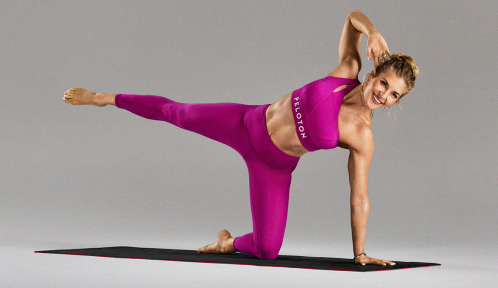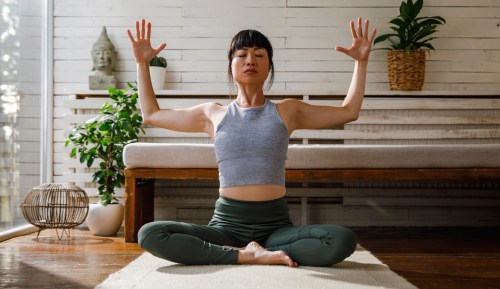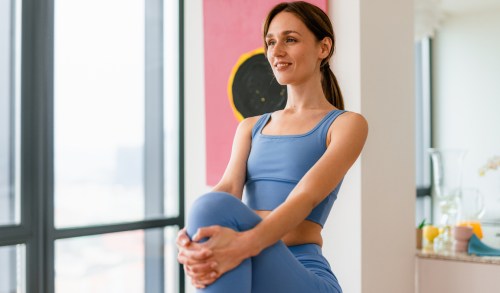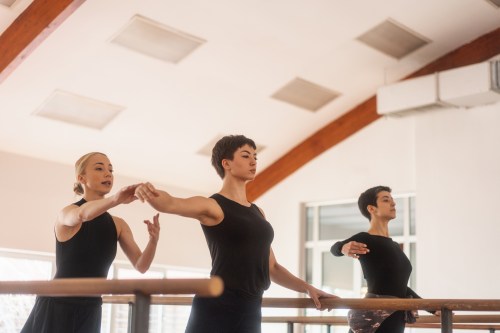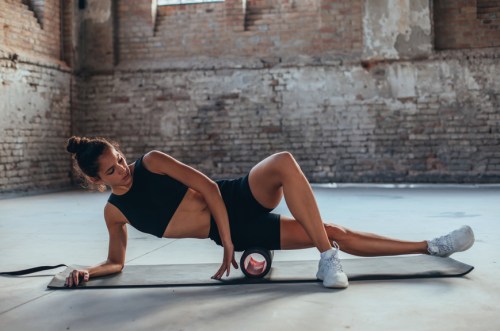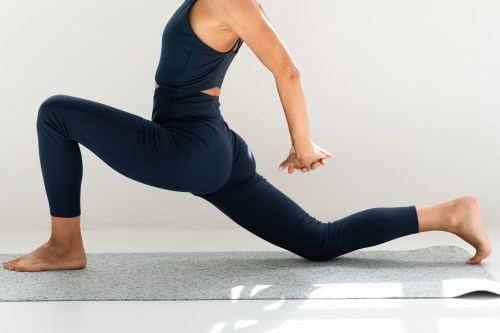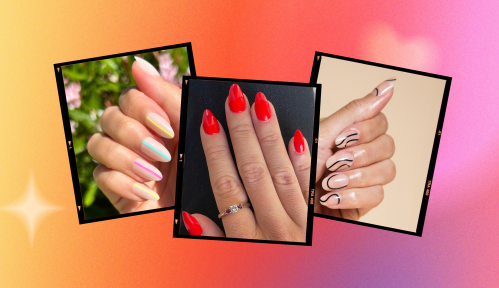Pilates was created in the 1920s in New York City by Joseph Pilates and many of its exercises were originally used to help World War I patients rehabilitate injuries. Today, Pilates is used more for fitness than for physical rehabilitation, although its focus on building a strong core may help prevent or speed along healing from other injuries.
Experts in This Article
certified personal trainer and Peloton instructor
If you’re considering giving this mind-and-body-focused workout a try, it’s key to have a grasp of Pilates’ foundational moves so that you can safely make the most of this muscle-building, endorphin-inducing workout.
The benefits of Pilates
Pilates is a unique fitness practice in that it focuses on more than just burning calories and achieving toned muscles—although you’ll do both of those things with a regular cadence of classes.
Pilates is focused on three principles, according to the Pilates Foundation: breath, whole-body health, and whole-body commitment, with “the whole-body encompassing mind, body and spirit.” Within those principles, the concepts of breath, concentration, centering, control, precision and flow are mainstays in any well-rounded Pilates practice.
“There are many benefits of Pilates that go beyond toning muscles or getting in a great workout,” says Rebecca Kennedy, CPT, a Peloton Pilates and Tread instructor. “Some of the top benefits of Pilates for me are that it improves posture and balance, helps with overall flexibility and mobility, and is low-impact and low-stress on your joints.”
Additionally, Kennedy notes Pilates can be an excellent complementary workout to other fitness activities like running, cycling, or strength training.
Lastly, Kennedy believes the mind-body connection that is achieved from a frequent Pilates workout is unmatched in the fitness world. “A regular Pilates practice will improve your mind-body awareness while improving mental focus and concentration,” Kennedy says. “Its emphasis on enhancing breathwork can also have the effect of reducing feelings of stress and anxiety.”
Beginner Pilates tips to keep in mind
Before diving into Pilates head first, remember to listen to your mind and body—it’s better to forego a move or modify it than cause yourself pain or injury. While it may be tempting to launch into some of the more advanced Pilates moves, it’s better to view each movement with “curiosity, instead of just trying to do each move and check off a box,” Kennedy says.
She recommends nailing the basics of the moves featured below—and not just acing the look of a move, but truly internalizing the breathing rhythm, form, and alignment of these foundational Pilates movements before becoming overly concerned with time spent in a movement, number of reps, or moving into more challenging variations of a move.
“A common misconception about Pilates is that you need to be flexible and also have a ton of equipment to get started with your practice,” Kennedy says. “Neither of these things are true. You do not need to be flexible to start a Pilates practice, and much of the equipment used is all extra, so don’t let either of those misconceptions hold you back from beginning a foundational practice.”
Finally, Kennedy reminds those who are new to Pilates that this is a slow, methodical practice. “Move slower than you think you need to, and always move with control,” Kennedy says. “Take modifications for any exercise that feels too challenging—it’s better to take a modification that allows you to maintain good form, breath control, and pelvic floor connection than to rush through a movement.”
The best Pilates exercises for beginners
Kennedy demonstrates each of the 10 moves in the video below. Follow along with her or scroll down for detailed exercise instructions.
1. The hundred
The Pilates hundred works your core and introduces the concept of timing your breath with your movements.
- 1.Lie flat on your back with knees bent and feet flat together on the floor.
- 2.Extend your arms up to the ceiling at shoulder height with your palms facing down.
- 3.Keeping your legs glued together, use your core to lift your legs into a tabletop position, with your feet off the mat, knees over ankles, and ankles in line with knees at a 90-degree angle.
- 4.Curl your head, neck, and chest up into a “crunch” position while reaching your arms toward your legs and extending your legs long on a diagonal line, about 45 degrees.
- 5.Keeping your wrists and fingers straight, start pumping the arms up and down in rapid, short movements while inhaling for five counts and exhaling for five counts.
- 6.Repeat the breath pattern ten times to reach 100.
2. Roll up
The roll up helps to build spine mobility and enforces the idea of maintaining a pelvic tuck for the entire duration of a rep.
- 1.Lie face-up with your arms extended over your head and your legs extended straight out in front of you.
- 2.Take a big inhale into your belly, and as you exhale, pull your pelvic floor in and up. Exhale while maintaining that tucked pelvic position.
- 3.On the next breath in, raise your arms up toward the ceiling. As you begin to exhale, curl your head, neck, and shoulders off the mat, rolling up one vertebrae at a time and using your lower abs to roll all the way up until your hands reach towards your feet.
- 4.Roll back down slowly, inhaling on the way down until your arms reach up and overhead.
- 5.Begin the next roll up on an exhale.
- 6.Repeat 10 times.
3. Pelvic tilt
The pelvic tilt is great for spinal mobility and to help you connect to your pelvic floor and abdominal muscles.
- 1.Lie face-up with with your knees bent and feet flat on the floor. Place your hands on your stomach.
- 2.Inhale, letting your ribs slightly expand and tilting your pelvis slightly away from your ribs, creating a small gap between your lower back and the floor.
- 3.On an exhale, pull upward from the pelvic floor by tilting in a posterior motion (an inward motion)—flattening your lower back against the mat. This counts as one rep.
- 4.Relax your core and back, then begin again, slow and controlled, for 10 reps.
4. Single-leg stretch
The single-leg stretch is great for your hips, core, and overall coordination.
- 1.Lie face-up with your legs extended.
- 2.Pull your right knee into your chest with your arms as you curl your head, neck, and shoulders off the mat. Hold for two counts
- 3.Then extend your right leg and pull your left knee into your chest.
- 4.Alternate legs for a total of 10 times.
5. Leg circle
The leg circle is great for hip mobility, hip stability, and core engagement.
- 1.Lie face-up with your legs extended and your arms down by your sides with your palms facing down.
- 2.Draw your right leg in toward your chest on an inhale, and on an exhale, extend your right leg straight up to the ceiling. You can flex or point your foot.
- 3.Keep your hips stable while drawing circles with your right leg in both directions. Start with small circles so you can ensure the movement engages your abs and that your hips stay stable.
- 4.Inhale, then draw your leg across your body and down toward the ground. On an exhale, lift it back up to the starting position.
- 5.Repeat 3-5 times per leg, drawing larger circles as your abs and hips become more engaged.
6. Side-lying leg kick
The side-lying leg kick is great for your hips and glutes as well as for your balance, coordination, and overall muscular stability.
- 1.Lie on your right side with your head propped up on your right hand. Place your left hand on the floor for stability.
- 2.Stack your hips, one on top of the other and position your legs slightly in front of you so that you can see them in your eye line.
- 3.Lift your left leg up to hip height, engaging your core and leg muscles as you do so.
- 4.Flex your left foot, then gently kick forward, pulsing your leg twice as you go.
- 5.Then, exhale, point your foot, and kick it behind you. That’s one rep.
- 6.Do 8-10 reps per leg.
7. The mermaid
The mermaid is an exercise that should feel “delicious,” Kennedy says. It’s a really good stretch that also works your core quite a lot.
- 1.Start in a kneeling position where you’re sitting on one of your glute muscles with your legs slightly off to the side, both knees bent with your feet behind you. Your bottom foot should be slightly tucked underneath you. Ensure you’re sitting tall with a straight spine and open chest.
- 2.Place your bottom hand on the floor slightly away from your hips. Your other arm will start by your ear.
- 3.Inhale and reach upward, sliding your bottom hand out to the side as you stretch away from your legs.
- 4.Come back to the starting position and switch arms. Ensure you maintain the tall and open posture even when switching sides.
- 5.Repeat for 8-10 reps per side.
8. Shoulder bridge leg extension
This move is an excellent foundational exercise for glute and hamstring strength as well as hip mobility and spinal mobility.
- 1.Lie face-up with your knees bent and feet flat on the floor, hip-width apart.
- 2.Squeeze your glutes and core, and press through your feet to drive your hips up toward the ceiling until you form a diagonal line from knees to hips to chest.
- 3.Straighten one leg out in front of you as you reach the opposite arm overhead, keeping your hips lifted and level.
- 4.Return your lifted arm and leg back down to the ground.
- 5.Repeat 8-10 reps per side.
9. Rolling like a ball
The “rolling like a ball” exercise not only helps to work on balance, coordination, spinal mobility and core strength.
- 1.Start in a sitting position with your legs bent and your feet on the floor.
- 2.Bend your knees as much as you need to grab your ankles.
- 3.Curl your spine into a ball and roll forward and backward on your spine while keeping your chin tucked. The goal is to not put your feet down between each rep. Rather, use your core to hold the proper shape at the top of each rep.
- 4.Do 8-10 reps.
10. The saw
The saw is excellent for both flexibility and core strength by using a little stretching motion while we’re in a straddle position, as well as adding in elements of rotation to build strength in your obliques.
- 1.Start in a seated position with your legs extended and slightly wider than hip-distance apart. Flex your feet so that your toes are pointing up. Sit tall with your spine stacked, ribs relaxed and chest open. Pull your shoulders down and away from your ears.
- 2.Open your arms out to your sides.
- 3.Twist from your torso over to one side, and then hinge forward as far as you can.
- 4.Take two pulses on an exhale.
- 5.Inhale back to the starting position.
- 6.Then, twist to the opposite side and repeat.
- 7.Repeat for 8-10 reps per side.
Sign Up for Our Daily Newsletter
Get all the latest in wellness, trends, food, fitness, beauty, and more delivered right to your inbox.
Got it, you've been added to our email list.
